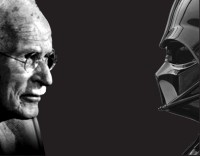 Humanities
Humanities
The Dark Side
 If you go to the official Star Wars website, you can read how the theories of psychiatrist Carl Jung have influenced the blockbuster film series. “Carl Jung is essentially the great-grandfather of Star Wars,” states the Star Wars in Mythology blog.
If you go to the official Star Wars website, you can read how the theories of psychiatrist Carl Jung have influenced the blockbuster film series. “Carl Jung is essentially the great-grandfather of Star Wars,” states the Star Wars in Mythology blog.
Among the many Jungian themes to manifest in Star Wars, the most dominant is “the shadow.”
The shadow, according to Jung, is the hidden side of our psyches, aspects of ourselves that are too violent, sexual, greedy or grandiose to acknowledge consciously. Star Wars explicitly sets up juxtaposition between the shadow or “dark side” and the good, and plays it out through characters such as Darth Vader.
Intrigued by the concept of the shadow, Michelle Maujean, who graduated in 2016, delved into it for a research paper for religious studies. She examined not just the shadow itself, but also Jung’s theory of how we can come to terms with disturbing parts of ourselves.
According to Jung, becoming a wholly integrated, mature human being (he calls this process “individuation”) means becoming consciously aware of these darker aspects of the self and finding appropriate expressions for them.
How does a psychological theory qualify for a research topic in religious studies? Mark Unno, an associate professor in religious studies, said the shadow theory “addresses both a psychological process and the possible religious dimensions of human experience.”
Maujean—who crosses over those boundaries herself, with degrees in religious studies and psychology—focused on case studies from a book by psychotherapist Robert Akeret, Tales from a Traveling Couch.
She analyzed two of Akeret’s former patients: Charles Embree, a young man who was “in love” with a circus polar bear, and Naomi Goldberg, an introverted and insecure college student who came to believe she was the reincarnation of a Spanish countess.
Embree eventually resolved his shadow self by becoming a professor who lectured on the circus; Goldberg ran away to Mexico and lived flamboyantly as a flamenco dancer named Isabella.
Maujean’s conclusion: Both found their place in society only through resolving their external and hidden personalities.
Throughout her research, Maujean demonstrated an exceptional ability to grasp theoretical concepts and relate them to the lives of real people, Unno said.
“She was able to take an outside theory, adapt it to a concrete example and give a critical analysis of the psychological process,” he added.
She received the religious studies department’s 2016 Jack T. Sanders Memorial Award for research projects that also spanned religion in war, terrorism and end-of-the-world beliefs.
—Alice Tallmadge


 Twitter
Twitter Facebook
Facebook Forward
Forward